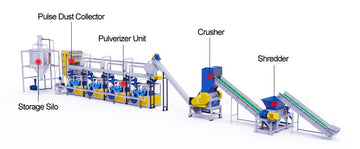Polyvinyl chloride, commonly known as PVC, is one of the most widely used plastics in the world. From building materials like pipes and windows to everyday products such as credit cards and flooring, PVC is a versatile material. However, its durability and widespread use have led to growing concerns about the environmental impact of PVC waste. Recycling PVC has become essential for reducing its negative impact on the environment, conserving resources, and promoting sustainability.
PVC is a durable and long-lasting material, which is both an advantage and a challenge. Its longevity means that once products made from PVC are discarded, they take a very long time to degrade, leading to accumulation in landfills and environmental pollution. Recycling PVC helps mitigate these issues by reducing the demand for new PVC production and diverting waste from landfills.
PVC Recycling Process
PVC recycling involves several stages, from collection to reprocessing, that transform PVC waste into reusable raw materials. Here’s an overview of the process:
- Collection and Sorting: The first step in recycling PVC is collecting discarded PVC products. These can range from construction waste, like pipes and windows, to consumer goods like packaging materials and automotive parts. After collection, the PVC waste is sorted based on type and quality, ensuring that only suitable materials enter the recycling stream.
- Cleaning: The collected PVC is then cleaned to remove dirt, contaminants, and any non-PVC materials that may have been mixed in. This step is crucial to ensure that the recycled PVC is of high quality.
- Shredding and Granulation: After cleaning, the PVC waste is shredded into smaller pieces. Shredders and granulators break the PVC into manageable sizes, making it easier to melt and process during the next stages.
- Melting and Reprocessing: The shredded PVC is melted down and reformed into new raw materials. These materials can take the form of pellets, granules, or sheets, depending on the intended end use. The recycled PVC can then be used in the production of new products, reducing the need for virgin plastic.
Types of PVC Recycling
There are two primary methods for recycling PVC: mechanical recycling and feedstock recycling.
- Mechanical Recycling: This is the most common method and involves physically shredding and granulating the PVC waste before melting it and reforming it into new products. Mechanical recycling is typically used for products like pipes, flooring, and windows.
- Feedstock Recycling: In feedstock recycling, the PVC is broken down into its chemical components through processes like pyrolysis or hydrolysis. The resulting chemicals can then be reused to produce new PVC or other materials. This method is less common but is gaining interest for recycling complex PVC products that cannot be processed mechanically.
PVC Recycling Equipment
Recycling PVC efficiently requires specialized equipment designed to handle the material’s unique properties. Here are some of the key machines used in PVC recycling:
1. PVC Shredders
PVC shredders are essential for breaking down large and bulky PVC products, such as pipes and profiles, into smaller, more manageable pieces. These machines are designed to handle the toughness of PVC while ensuring that the material is reduced to a uniform size for further processing.
2. Granulators
Granulators are used after shredding to further reduce the size of PVC waste into fine granules or pellets. This step is critical in ensuring that the PVC can be melted and reformed efficiently. Granulators typically have high-speed rotating blades that cut the shredded material into smaller particles.
3. PVC Densifiers
PVC densifiers are used to compress and compact lightweight PVC waste, such as films or sheets, into denser, easier-to-handle forms. This equipment is particularly useful for reducing the volume of PVC waste before it is processed further, making transportation and storage more efficient.
4. Extruders
Extruders are used in the final stage of PVC recycling. These machines melt the granulated PVC and reform it into new shapes, such as pellets, sheets, or profiles. Extruders allow for the production of a wide variety of products from recycled PVC, making them a versatile tool in the recycling process.
5. PVC Pulverizers
Pulverizers are used to turn PVC waste into fine powders, which can be used to create new products. This process is especially useful for producing PVC powders for the manufacturing of flooring, roofing materials, and other products that require finely ground PVC.
Benefits of Using PVC Recycling Equipment
Investing in PVC recycling equipment offers numerous benefits for businesses and recycling facilities:
- Cost Efficiency: By recycling PVC, companies can reduce their reliance on virgin materials, lowering production costs and saving resources.
- Environmental Impact: Recycling PVC helps reduce the environmental footprint of plastic production, cutting down on the waste sent to landfills and minimizing pollution from new PVC production.
- Sustainability: As businesses and consumers become more eco-conscious, using recycled PVC helps companies meet sustainability goals and demonstrate a commitment to environmental responsibility.

